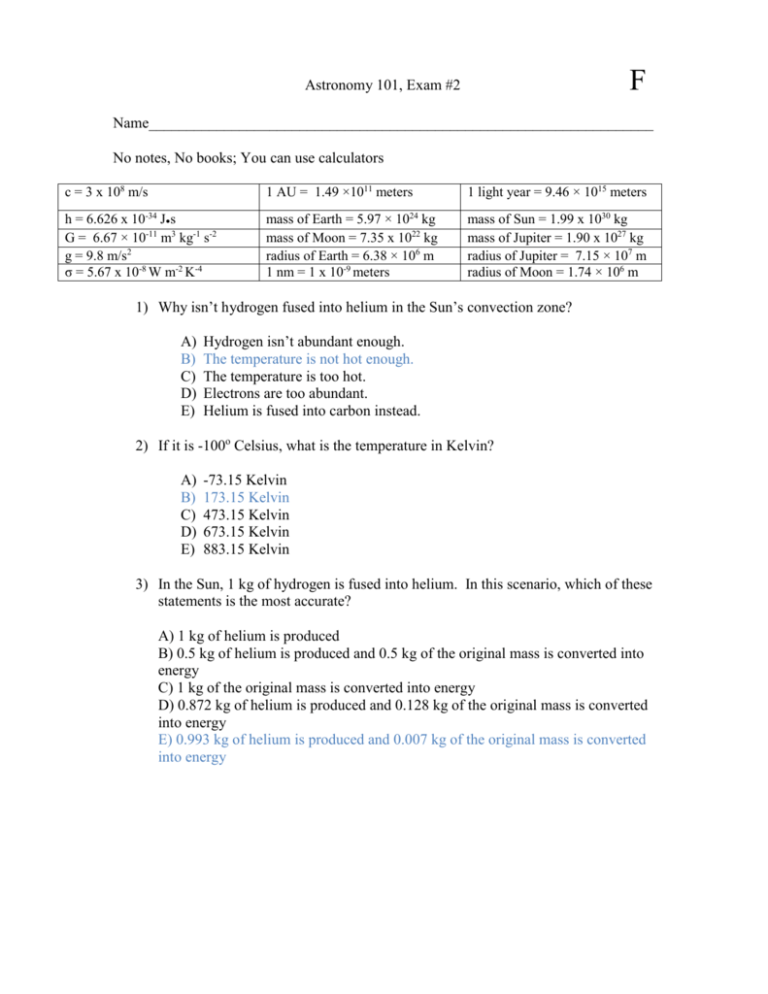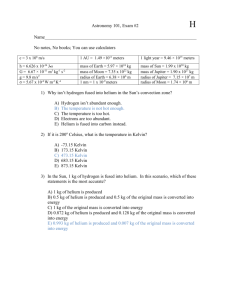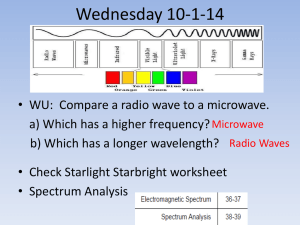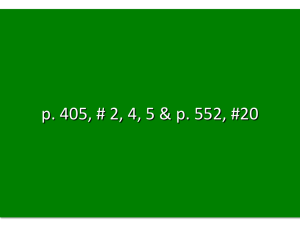Name - MIT
advertisement

F Astronomy 101, Exam #2 Name___________________________________________________________________ No notes, No books; You can use calculators c = 3 x 108 m/s 1 AU = 1.49 ×1011 meters 1 light year = 9.46 × 1015 meters h = 6.626 x 10-34 J●s G = 6.67 × 10-11 m3 kg-1 s-2 g = 9.8 m/s2 σ = 5.67 x 10-8 W m-2 K-4 mass of Earth = 5.97 × 1024 kg mass of Moon = 7.35 x 1022 kg radius of Earth = 6.38 × 106 m 1 nm = 1 x 10-9 meters mass of Sun = 1.99 x 1030 kg mass of Jupiter = 1.90 x 1027 kg radius of Jupiter = 7.15 × 107 m radius of Moon = 1.74 × 106 m 1) Why isn’t hydrogen fused into helium in the Sun’s convection zone? A) B) C) D) E) Hydrogen isn’t abundant enough. The temperature is not hot enough. The temperature is too hot. Electrons are too abundant. Helium is fused into carbon instead. 2) If it is -100o Celsius, what is the temperature in Kelvin? A) B) C) D) E) -73.15 Kelvin 173.15 Kelvin 473.15 Kelvin 673.15 Kelvin 883.15 Kelvin 3) In the Sun, 1 kg of hydrogen is fused into helium. In this scenario, which of these statements is the most accurate? A) 1 kg of helium is produced B) 0.5 kg of helium is produced and 0.5 kg of the original mass is converted into energy C) 1 kg of the original mass is converted into energy D) 0.872 kg of helium is produced and 0.128 kg of the original mass is converted into energy E) 0.993 kg of helium is produced and 0.007 kg of the original mass is converted into energy Astronomy 101, Exam #2 F 4) A photon has a frequency of 1 x 1015 Hz. What is the wavelength of this photon? A) B) C) D) E) 3 x 1023 meters 6.626 x 10-19 meters 3 x 107 meters 3.33 x 106 meters 3 x 10-7 meters 5) As the frequencies of photons of light increase, their … A) B) C) D) E) Wavelengths increase and their energies increase Wavelengths decrease and their energies increase Wavelengths decrease and their energies decrease Wavelengths increase and their energies stay the same Wavelengths stay the same and their energies stay the same 6) Which of the following objects has the most kinetic energy? A) A 100 kg mass moving at 1 km/s. B) A 20 kg mass moving at 2 km/s. C) A 2 kg mass moving at 5 km/s. D) A 10 kg mass moving at 4 km/s. E) A 5 kg mass moving at 2 km/s. 7) The Homestake Gold Mine experiment was designed to detect neutrinos. What insight can be gained from such an experiment? A) The rate that visible light from the Sun is being absorbed by the Earth’s atmosphere B) The rate that hydrogen is being fused into helium in the Sun C) The rate that gamma rays are hitting the Earth’s atmosphere D) The rate that white dwarfs are being formed in the galaxy E) The rate that stars form in the galaxy 8) A K5 star and a B3 star both have an apparent magnitude of +0.5 in the visible wavelength region. Both stars are 144 light years from Earth. Which of these statements is the most accurate to say? A) B) C) D) E) The K5 star will be twice as bright as the B3 star The B3 star will be twice as bright as the K5 star Both stars have the same surface temperature. Both stars have the same luminosity. Both stars are primarily composed of iron Astronomy 101, Exam #2 F 9) How many hydrogen atoms fuse to produce one helium atom? A) 1 B) 2 C) 4 D) 5 E) 6 10) What is the frequency of a photon of light if the wavelength is 5 x 1029 meters? 6 x 1015 Hertz 1.5 x 10-36 Hertz 1.5 x 1037 Hertz 1.5 x 1036 Hertz 6 x 10-22 Hertz A) B) C) D) E) 11) Luminosities of stars are usually given in units of … A) B) C) D) E) Newtons Parsecs Kilograms Watts Gauss 12) You take an image of the sky. On the image, a star has an apparent magnitude of +8, a main-belt asteroid has an apparent magnitude of +6, a Kuiper Belt Object has an apparent magnitude of +17, a Trojan asteroid has an apparent magnitude of +14, and Pluto has an apparent magnitude of +15. Which object is faintest in the sky? A) B) C) D) E) The star The main-belt asteroid The Kuiper Belt Object The Trojan asteroid Pluto 13) What is the primary reason why so many telescopes are located on Mauna Kea? A) They can be open 24 hours and 7 days of week B) The telescopes are above a significant amount of the Earth’s atmosphere C) You do not have to worry at all about the distorting effects of the Earth’s atmosphere D) Gamma-rays from stars can be observed on Mauna Kea E) The telescopes are much close to the objects they will study Astronomy 101, Exam #2 F 14) Why are X-ray telescopes located in space and not on the surface of the Earth? A) B) C) D) E) X-rays are dangerous to humans. X-rays cannot penetrate deep into the Earth’s atmosphere X-rays tend to make the telescopes radioactive X-rays pass through mirrors on Earth and are not detected X-rays do not interact with silicon in mirrors properly on the surface of the Earth 15) Somebody says that a spectrum of a star appears blueshifted. What is happening to the star? A) B) C) D) E) The star is getting hotter The star is getting colder The star is moving towards you. The star is moving away from you The star is getting larger 16) A star is 20 light years from Earth. The star is moved so it is 10 light years from Earth. How will the brightness of the star change as seen from Earth? A) B) C) D) E) The brightness will not change The star will become twice as bright. The star will become four times brighter The star will become eight times brighter. The star will become sixteen times brighter. 17) Different isotopes of an element have different numbers of … A) B) C) D) E) Neutrons Protons Isotopes Neurons Neutrinos 18) How much kinetic energy does a 1 kg ball with a velocity of 2 km/s have? A) 4 x 106 Joules B) 2 x 106 Joules C) 2 Joules D) 4 Joules E) 2,000 Joules Astronomy 101, Exam #2 F 19) All the stars on the main sequence … A) B) C) D) E) Have the same brightness Fuse hydrogen into helium as their primary energy source Have the same temperature Fuse helium into carbon as their primary energy source Become black holes after they leave the main sequence 20) Put these parts of the electromagnetic spectrum in order from shortest wavelength to longest wavelength: Shortest Longest wavelength A) B) C) D) E) Infrared, Radio, visible, ultraviolet, X-ray, gamma-ray Gamma-ray, X-ray, ultraviolet, visible, infrared, radio Radio, visible, ultraviolet, X-ray, gamma-ray, infrared Radio, infrared, visible, ultraviolet, X-ray, gamma-ray Radio, X-ray, infrared, ultraviolet, visible, gamma-ray 21) The hottest part of the Sun is the … A) B) C) D) E) Radiation zone Convection zone Photosphere Corona Core 22) As the temperature increases for an object, the peak of its blackbody radiation curve measured for the object moves to … A) B) C) D) E) Lower intensities and longer wavelengths Higher intensities and shorter wavelengths Lower intensities and shorter wavelengths Higher intensities and longer wavelengths Does not change in intensity or in wavelength position 23) The temperature of the visible surface of the Sun is approximately … A) 2,300 K B) 100,000,000 K C) 5,800 K D) 4,100 K E) 1,000 K Astronomy 101, Exam #2 F 24) What apparent magnitude in the visible wavelength region for a star makes it impossible to see with the naked eye? A) B) C) D) E) -1.5 0 +1 +3 +8 25) Absolute zero has a temperature of … A) 100o C B) 0o C C) 273.15o C D) -273.15o C E) -100o C 26) The densest part of the Sun is the … A) B) C) D) E) Radiation zone Convection zone Photosphere Corona Core 27) A prism can be used to break light up into its constituent spectral colors since different wavelengths of light are refracted differently by glass and leave the prism at different angles. What is the order of the colors of the light from smallest to highest frequency? Smallest Highest frequency A) B) C) D) E) Violet, Indigo, Red, Blue, Green, Yellow, Orange Red, Orange, Yellow, Green, Blue, Indigo, Violet Red, Yellow, Orange, Blue, Green, Indigo, Violet Violet, Indigo, Green, Blue, Orange, Yellow, Red Violet, Indigo, Green, Yellow, Orange, Red, Blue 28) The Sun emits most of its radiation in what part of the electromagnetic spectrum? A) B) C) D) E) Gamma-ray X-ray Ultraviolet Visible Infrared Astronomy 101, Exam #2 F 29) What two wavelength regions do telescopes that are most commonly found on the surface of the Earth observe in? A) gamma and X-ray B) visible and radio C) gamma and ultraviolet D) X-ray and infrared E) X-ray and ultraviolet 30) Which of these parts of the electromagnetic spectrum has the shortest wavelength? A) B) C) D) E) Radio waves X-rays infrared ultraviolet visible 31) The most abundant element in the Sun is … A) oxygen B) silicon C) carbon D) hydrogen E) helium 32) The Hertzsprung-Russell Diagram plots the luminosities and temperatures of … A) B) C) D) E) dwarf planets planets stars asteroids satellites 33) Put these stars in order from hottest to coldest surface temperatures: A3, B2, F7, K6, M8. Hottest Coldest surface temperature A) B2, A3, K6, F7, M8 B) M8, K6, F7, A3, B2 C) A3, B2, F7, K6, M8 D) B2, A3, F7, K6, M8 E) F7, B2, A3, M8, K6 Astronomy 101, Exam #2 F 34) The term “blackbody” refers to an idealized object that … A) is moving faster than the speed of light B) absorbs all radiation incident on its surface and then emits radiation based on its temperature.. C) is at a temperature of absolute zero and, therefore, appears black since it does not emit any radiation D) is formed from electrons ejected by a plasma E) emits only radio waves when heated and only visible light when cooled 35) The atomic number of an element is equal to the number of ____________ that are found in an atom of an element. A) neutrons and electrons. B) protons. C) protons and neutrons. D) protons and electrons. E) neutrons. 36) Which of these spectral types has the longest lifetime on the main sequence? A) B type B) A type C) K type D) O type E) F type 37) For main sequence stars, the general rule is that the lower the surface temperature, … A) the greater the size of the core B) the greater the masses of the stars. C) the less luminous are the stars. D) the greater the diameter of the star E) the shorter the lifetime on the main sequence Astronomy 101, Exam #2 F 38) What is the biggest advantage of putting a telescope on the Moon than on the Earth? A) The Moon-based telescope will be easier to fix. B) The Moon-based telescope will be much closer to the objects in space that it will it study. C) You do not have to worry about the distorting effects of the Earth’s atmosphere D) The Moon-based telescope will be cheaper to build. E) Your telescope on the Moon will not be struck by charged particles. 39) Which of these spectral types will have a surface temperature most similar to the Sun? A) B) C) D) E) M5 M2 G2 B4 K3 40) What is the energy of a photon with a frequency of 5 x 106 Hz? A) B) C) D) E) 3.313 x 10-30 Joules 1.9878 x 10-33 Joules 3.313 x 10-27 Joules 1.9878 x 10-25 Joules 1.9878 x 10-31 Joules









